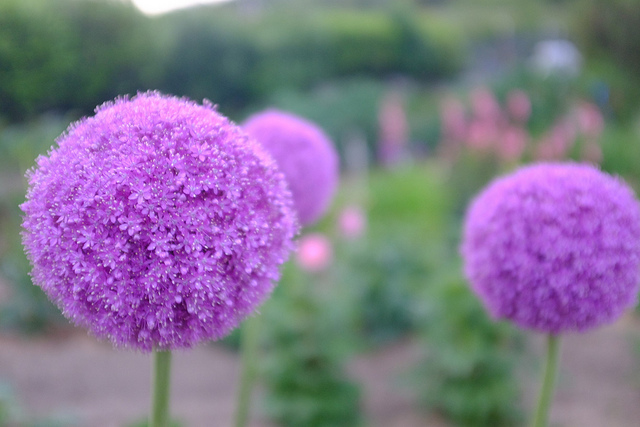*skip to photos here*
Happy to escape city life for a few days, we decided to spend a weekend on the island of Naoshima, a small, hilly island in the Seto Inland Sea. A few decades ago, the Benesse Corporation (a publishing house and parent company of the Berlitz Language Schools) built various museums to house some key pieces of their contemporary art collection. In addition, there are a many large sculptures dotting the island, so the whole island almost seems like one big museum.
Taking advantage of a beautifully sunny day, we set off on rented bicycles for a full day of museum-hopping, stopping first at the Chichu Art Museum. Renowned Japanese architect Tadao Ando (who is self-taught!) designed this underground structure using concrete, steel, glass, and wood. The galleries’ artworks are illuminated by natural light only, and house water lilies by Monet (in a room you entered with white slippers), and installations both by Walter de Maria and James Turrell. The surrounding landscape was designed with Monet in mind; lovely water lily ponds, and a wild array of flowers. Phil and I immediately declared this one of our favorite museums in the world (although it hardly de-throned my No. 1, the Fondation Beyeler).
Pedaling on, we arrived at the Benesse House Museum (designed by Ando as well), both a museum and high-end hotel. For upwards of USD 400, guests can wander among works by the likes Warhol and Pollock whenever they want. We opted for the USD 10-visitor passes instead… Phil was impressed by “The World Flag Ant Farm,” a piece by Yukinori Yanagi (a Japanese artist I had never heard of) who had created a series of interconnecting boxes filled with colored sand in the patterns of national flags, linking them by plastic tubes. After releasing ants into the system, the insects were able to travel and create a cross-cultural, multi-national network. Amusing!
My only disappointment was that we weren’t allowed to take pictures. I know there’s something to be said for NOT having cameras clicking in the background, or people running around in search of the perfect Kodak moment. At the same time, I enjoy capturing my own perspective of whatever I’m seeing, and it irks me greatly when this is forbidden − especially when it wouldn’t harm the artwork. My little rebellious streak got the better of me this time, and I ended up secretly taking sneaky pictures whenever the guards weren’t looking. Sadly, none of the photos turned out, but it made me feel better.
After a sushi lunch, our third art-related stop was the Art House Project; half a dozen restored buildings in the old fishing village of Honmura. The buildings have been turned over to contemporary artists as the setting for installations, and we marveled at the different approaches taken. A huge statue of liberty parked in one house was impressive, as was another installation by James Turrell. His work focuses on experiments with light, and in “Back Side of the Moon,” we were lead into a completely dark room. Over the course of the next ten minutes, a white screen gradually revealed itself. This wall of light turned out to always have been there; it was just the eyes that required adjusting. It seemed to be a wonderful and simple lesson: “Even in Darkness, there is Light; you just have to see it.” The young Japanese man working at this site offered a lengthy explanation, and it seemed there was a lot of background information. I was hoping we would get the translation, when his voice sounded out of the dark in English: “Excuse me… you see light? Yes? Okay.”
Naoshima turned out to be a prime example of how nature, art, and architecture can be mixed harmoniously. While there, we also spent our first night at a Minshuku, a Japanese Bed & Breakfast. The tatami room we rented from a lady we had contacted via email − requested, as she spoke no English and likely translated what we wrote online − was wonderful, and allowed for the discovery of the Cat Café (our host’s other business). For about 5 dollars, visitors could spend 30 minutes in a little room frolicking with a bunch of cats wearing pinafores… only in Japan!

